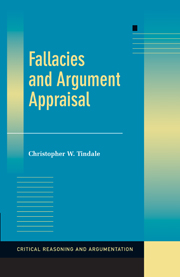Book contents
1 - INTRODUCTION TO THE STUDY OF FALLACIOUSNESS
Published online by Cambridge University Press: 05 June 2012
Summary
Strong and Weak Arguments
Arguments have a range of types and employ a diversity of devices, from those that press a historical case using causal reasoning to those that recommend an economic course of action by appealing to an authority in the field. They will be characterized by a particular structure, where one or more statements (premises) are given in support of a conclusion, and a range of intentions: to persuade an audience, to resolve a dispute, to achieve agreement in a negotiation, to recommend an action, or to complete an inquiry. Because of these different intentions, arguments arise in different contexts that are part of the argumentative situation. Arguments also have a range of strengths, from those that conform to the principles of good reasoning to those that commit some of the more abysmal errors we will be considering in this book. In between are degrees of strength and weakness. In fact, many arguments of a more extended nature will admit of merits and demerits that can make our judgment about the overall quality of the reasoning quite difficult. A ‘fallacy’ is a particular kind of egregious error, one that seriously undermines the power of reason in an argument by diverting it or screening it in some way. But a more precise definition is difficult to give and depends on a range of considerations.
- Type
- Chapter
- Information
- Fallacies and Argument Appraisal , pp. 1 - 18Publisher: Cambridge University PressPrint publication year: 2007



